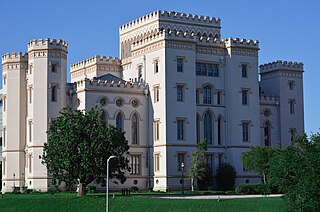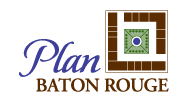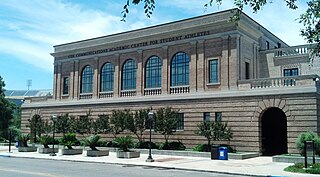Related Research Articles

Baton Rouge is the capital city of the U.S. state of Louisiana. Located on the eastern bank of the Mississippi River, it had a population of 227,470 as of 2020; it is the seat of Louisiana's most populous parish (county-equivalent), East Baton Rouge Parish, and the center of Louisiana's second-largest metropolitan area and city, Greater Baton Rouge.

Louisiana State University is an American public land-grant research university in Baton Rouge, Louisiana. The university was founded in 1860 near Pineville, Louisiana, under the name Louisiana State Seminary of Learning & Military Academy. The current LSU main campus was dedicated in 1926, consists of more than 250 buildings constructed in the style of Italian Renaissance architect Andrea Palladio, and the main campus historic district occupies a 650-acre (260 ha) plateau on the banks of the Mississippi River.

Baton Rouge Magnet High School is a public magnet school in Baton Rouge, Louisiana, United States, founded in 1880. It is part of the East Baton Rouge Parish School System with a student body of approximately 1500 students. The current building was built in 1926, and, as Baton Rouge High School, was listed on the National Register of Historic Places in 1986. The campus underwent a two-year renovation and expansion starting in 2010, resulting in the addition of two new wings to the main building. This renovation was completed and the school reopened in fall 2012. Baton Rouge High is also one of the highest-ranked schools in the state, and consistently wins state-level academic competitions. The school requires students to pass enrollment standards and exceed graduation standards. As a result, nearly all graduating students attend college.

Tiger Stadium is an outdoor stadium located in Baton Rouge, Louisiana, on the campus of Louisiana State University. It is the home stadium of the LSU Tigers football team. Prior to 1924, LSU played its home games at State Field, which was located on the old LSU campus in Downtown Baton Rouge.
Baton Rouge Area Foundation is a community foundation dedicated to enhancing the quality of life in Louisiana's capital region, and is registered with the IRS as a 501(c)(3) tax-deductible nonprofit organization. Since inception, the Foundation has granted over $650 million.

Catholic High School is a private, Catholic college-preparatory day school run by the United States Province of the Brothers of the Sacred Heart in Baton Rouge, Louisiana. It was founded in 1894 as St. Vincent's Academy. It offers grades eight through twelve.

The East Baton Rouge Parish School System, also known as East Baton Rouge Schools or the East Baton Rouge Parish School Board, is a public school district headquartered in Baton Rouge, Louisiana, United States. The district serves most of East Baton Rouge Parish; it contains 54 elementary schools, 16 middle schools, and 18 high schools. The EBR Public Schools district is the second largest in the state.

Louisiana Highway 30 (LA 30) is a state highway located in southeastern Louisiana. It runs 28.10 miles (45.22 km) in a northwest to southeast direction from LA 73 in Baton Rouge to the junction of U.S. Highway 61 (US 61) and LA 431 east of Gonzales.
The Center for Computation and Technology (CCT) is an interdisciplinary research center located on the campus of Louisiana State University in Baton Rouge, Louisiana.
Louisiana Speaks was a regional plan, published in May 2007, and planning organization for southern Louisiana created in the wake of the destruction caused by Hurricanes Katrina and Rita.

Plan Baton Rouge is a master plan for the redevelopment of the downtown of Baton Rouge, Louisiana. The plan is based on New Urbanist principles.

Istrouma High School is an accredited public school located in Baton Rouge, Louisiana, United States. It was founded in 1917, and is located in East Baton Rouge Parish. Its name is a local Indian word meaning "red stick". Red stick is also the English language translation of the French words baton rouge. The area of north Baton Rouge where the school is located is also known as the Istrouma area.
Baton Rouge, Louisiana has many historic neighborhoods, dating back as far as the early 19th century.

The foundation of Baton Rouge, Louisiana, dates to 1721, at the site of a bâton rouge or "red stick" Muscogee boundary marker. It became the state capital of Louisiana in 1849.
The Louisiana Business & Technology Center (LBTC) at Louisiana State University plays an important role to the state's flagship university, Louisiana State University as a part of LSU's Office of Research and Economic Development. LBTC's primary goal is to increase the economic growth of Louisiana by enhancing the development of small businesses and assisting in the development of new businesses. The center is ranked among the top ten entrepreneur programs in the nation. In 1988 it was jointly funded through LSU and the Greater Baton Rouge Chamber of Commerce to foster economic growth in Louisiana by providing businesses with applications and tools necessary for growth and survival in the real world. It comprises the Louisiana Technology Transfer Office (LTTO), the LBTC Business Incubator, and the LSU Student Incubator.

The Tiger Athletic Foundation (TAF) is a private, non-profit corporation dedicated to supporting Louisiana State University (LSU) and its athletics program. It is the primary source of private funding for LSU athletics and contributions to TAF benefit every athlete and every team at LSU. TAF has become a critical element in the success of LSU Athletics by providing private funding for scholarships, academic rewards, new athletic facilities and facility upgrades. In addition to contributions to the athletic scholarship fund, TAF will continue to provide funding for academic programs and facilities that benefit all LSU students.

The LSU Cox Communications Academic Center for Student-Athletes, on the campus of Louisiana State University in Baton Rouge, Louisiana, is located in the Gym/Armory building. The building opened in 1930 and was completely renovated and reopened in 2002 to house the Academic Center for Student-Athletes.

The LSU Gym Armory building on the campus of Louisiana State University in Baton Rouge, Louisiana was completed in 1930.
St. George is the newest incorporated city in Louisiana. It was approved in a ballot initiative on October 12, 2019. Upon incorporation, it became the fifth largest city in Louisiana and the second largest in East Baton Rouge Parish with a population of 86,316. The city originated from a previously unincorporated area of East Baton Rouge Parish located southeast of the City of Baton Rouge.